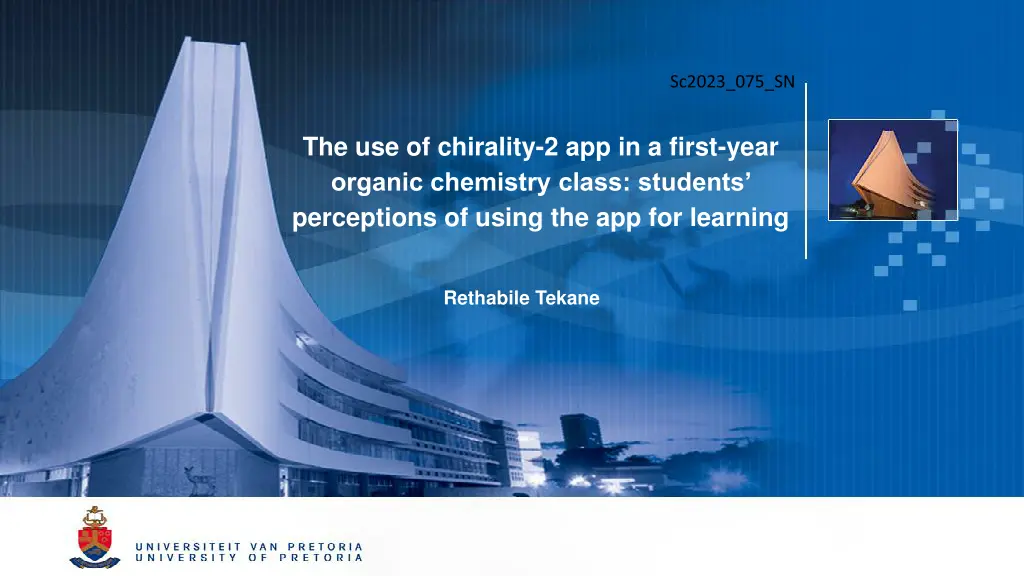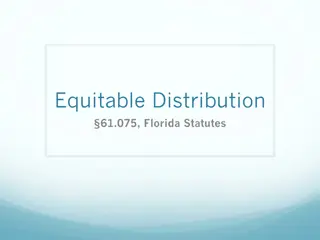
Perceptions of Using Chirality-2 App in Organic Chemistry Learning
Explore the perceptions of first-year chemical engineering students using the Chirality-2 app in learning organic chemistry. This study aims to evaluate student experiences and attitudes towards the app, employing phenomenography as the theoretical framework. The research delves into how students perceive and engage with this educational tool, providing valuable insights for enhancing organic chemistry learning in academic settings.
Download Presentation

Please find below an Image/Link to download the presentation.
The content on the website is provided AS IS for your information and personal use only. It may not be sold, licensed, or shared on other websites without obtaining consent from the author. If you encounter any issues during the download, it is possible that the publisher has removed the file from their server.
You are allowed to download the files provided on this website for personal or commercial use, subject to the condition that they are used lawfully. All files are the property of their respective owners.
The content on the website is provided AS IS for your information and personal use only. It may not be sold, licensed, or shared on other websites without obtaining consent from the author.
E N D
Presentation Transcript
Sc2023_075_SN The use of chirality-2 app in a first-year organic chemistry class: students perceptions of using the app for learning Rethabile Tekane
1st year chemical engineering students enroll in a chemistry course covering physical-analytical & organic chemistry sections. Rationale Pass rates for this course have been lower than 75%. Majority of students complain about organic chemistry. Chirality-2 app (Jones, Spichkova, & Spencer, 2018). included as one of the learning supports students can use for learning organic chem. 2
Aim: evaluate chirality-2 app by investigating Aim(s) & Research Questions students perceptions of using the app for learning organic chemistry. Research Question(s): i. What are students perceptions of using chirality-2 app for learning organic chemistry? 3
Aims to describe perceptions and experiences people have towards a given phenomenon (Marton 1981; Bodner & Orgill, 2007). Theoretical Framework: Phenomenography Concentrates on how people experience, understand or perceive a phenomenon (Orgill, 2007). 4
Chirality-2 App Game based app Covers introductory organic chemistry topics Free to download on IOS and Android devices 5 (Jones, Spichkova, & Spencer, 2018).
Participants Recruitment Students enrolled Done in class at in the course beginning of semester Methods Sampling Purposeful sampling 6
4. Thematic analysis Methods: 5. Peer debriefing & analysis 3. Interviews 2. Thematic analysis 1. Reflective Journals 7
Bodner G. M. and Orgill M., (2007), Theoretical frameworks for research in chemistry/science education, Upper Saddle River, NJ: Pearson/Prentice Hall. Etikan, I., Musa, S. A., & Alkassim, R. S. (2016). Comparison of convenience sampling and purposive sampling. American journal of theoretical and applied statistics, 5(1), 1-4. Jones, O. A. H., Spichkova, M. & Spencer, M. J. S. (2018). Chirality-2: Development of a Multilevel Mobile Gaming App To Support the Teaching References of Introductory Undergraduate-Level Organic Chemistry. Journal of Chemical Education, 95 (7), 1216 1220. Marton F., (1981), Phenomenography: describing conceptions of the world around us, Instruct.Sci., 10(2), pp 177 200. Orgill M., (2007), Phenomenography, in Bodner G. M. and Orgill M. (ed.), Theoretical frameworks for research in chemistry/science education, Upper Saddle River, NJ: Pearson, pp. 132 151. 8

